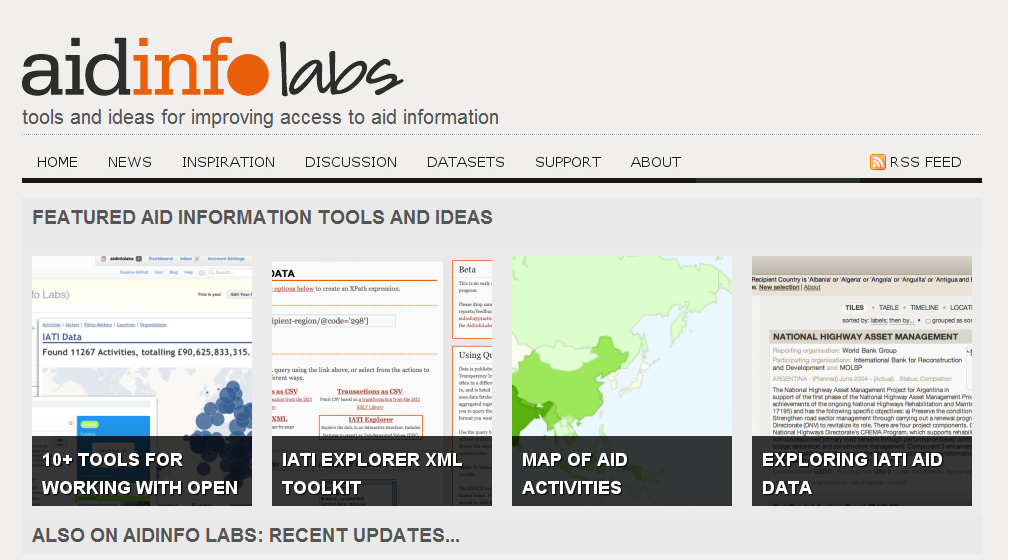The following is a guest post from Tim Davies, open data action researcher, currently curating the aidinfolabs.org website for aidinfo, and a member of the OKFN Working Group on Open Development.
The International Aid Transparency Initiative (IATI) was set up in 2008 by 18 leading international development organisations. It aims to make information about aid spending easier to access, use and understand. Since the start of this year IATI has been making great progress securing access to data on aid activities and spending, with an agreed machine-readable data standard, a licensing framework, a registry of available data (based on the OKF’s CKAN software), and political commitments from over 20 donor countries and agencies to publish IATI data in the next year.
Alongside the IATI Standard and Registry which focus on making data accessible, aidinfolabs.org provides a space to share efforts in making IATI data easier to understand and use: turning raw data into information that makes a difference. With a recent barcamp focussed on IATI data in Katmandu, a hack-day coming up in Berlin, and a growing community of users, we recently relaunched the aidinfo labs site to make sure we had all the ingredients that might be needed to make timely and accessible aid information a reality. We’ve created space for:
- People: given the global development focus of IATI data, there can often be a distance between developers and data-wranglers working with data, and the people with some of the strongest demands for accessible aid information. We’ve put a ‘people’ section at the heart of the site where we’re going to be profiling real users of IATI data, and where we’re collecting a range of ‘open personae’ profiles, resources to give anyone working with the data a head-start in taking user-centred design approaches.
-
Plans: we’ve been finding that often similar ideas for working with a dataset can emerge at the same time in different places. By encouraging potential users of the data to share their plans and ideas at the start of a project, we can hopefully help collaborations emerge. The plans section also makes sure people with ideas for making aid information accessible and useful, but without the time or resources to put them into practice, can share the ideas.
-
Prototypes: there are already many prototypes built to show the potential of IATI data, from the IATI Explorer and IATI Data Ruby on Rails app, to visualisations of aid flows, graphs of funding allocated to projects, and ongoing work to convert IATI data for use in open spending, or to make it available as linked data. Some of these prototypes are ongoing works-in-progress, others were one-off experiments, created to explore and learn about the data. We’ve encouraged prototype creators to share source code or how-to’s so that others can build on their work in future.
-
Products: We’ve created a space for products that ‘graduate’ out of the labs and we’re working on a check-list that will help us identify the stable and supported IATI-using products that we can point users at when they want direct access to information and data, without sifting through different prototypes.
We’ve also brought together sections on the site for:
- Datasets – showing that IATI is one amongst a number of open datasets. We’re using the CKAN API so that our list of datasets is kept up to date directly from The Data Hub.
-
Support – providing quick access to How To guidance, shared source code and tools that make working with the data easier, such as the IATI Explorer Toolkit, which takes all the different IATI XML files and gives easy access to query across them and fetch back the data in a number of formats.
As we’ve been reminded recently from a number of angles, open data alone isnot enough. Aidinfo labs is part of our action learning to discover what else we need to add to data to make a difference, and discovering effective approaches to curating a growing global dataset.
###Get involved:
With 10 more donors due to publish IATI data in the coming months, and the potential for IATI data to cover more than 50% of global aid by value by next year, there’s great potential for working with the data. If you’ve got ideas or experience to share, head over to the aidinfo labs site and get involved.
If you’re interested in wider issues of how open data and access to information can impact global development join discussions on the open-development working group mailing list.
Theodora is press officer at the Open Knowledge Foundation, based in London. Get in touch via press@okfn.org










Open Knowledge Foundation Blog,
Is a great source of information about aid spending easier to access; it is a very interesting topic.